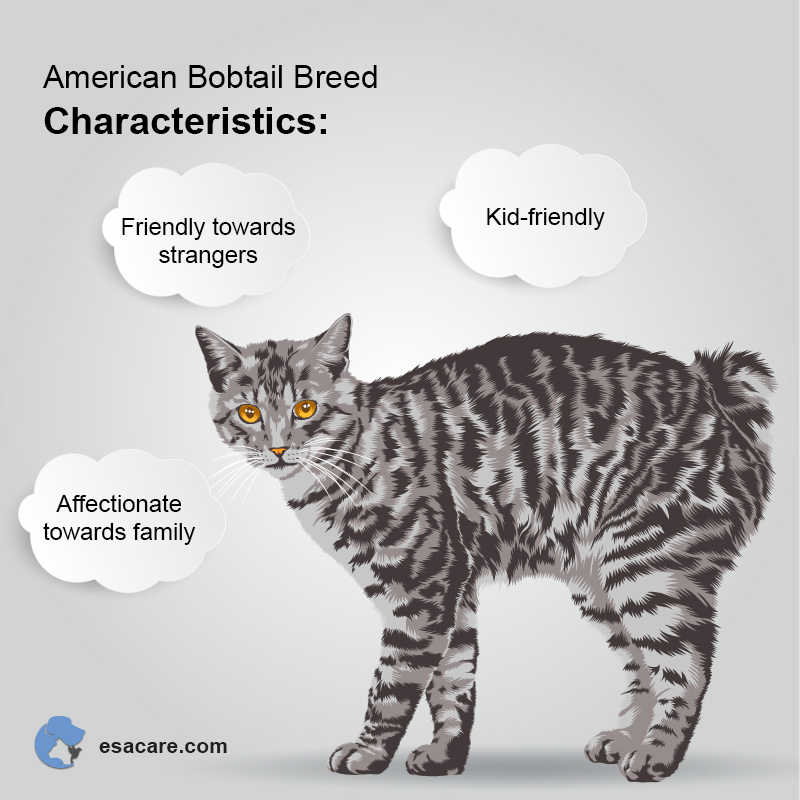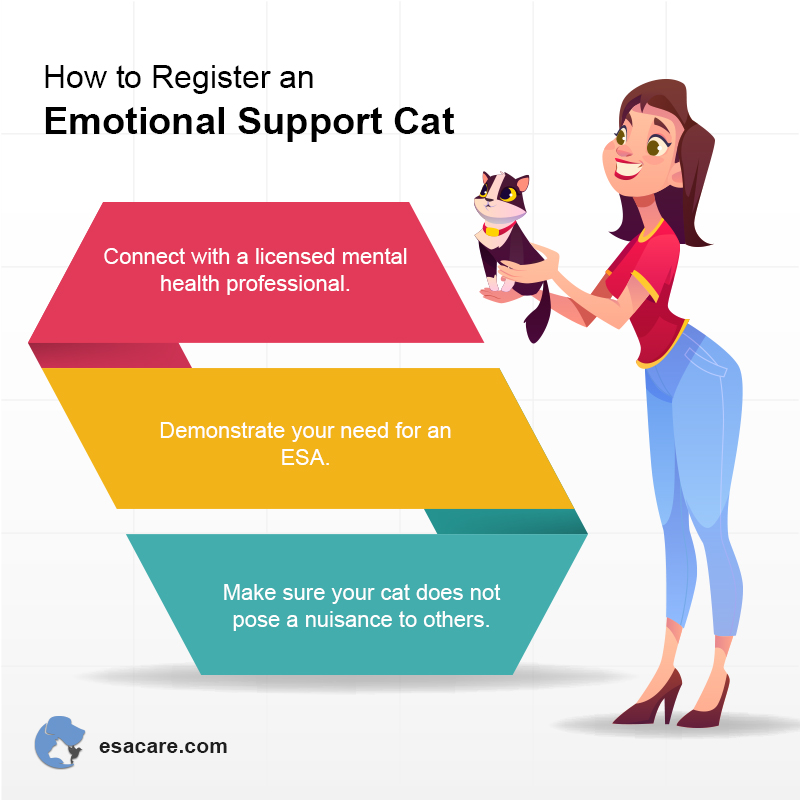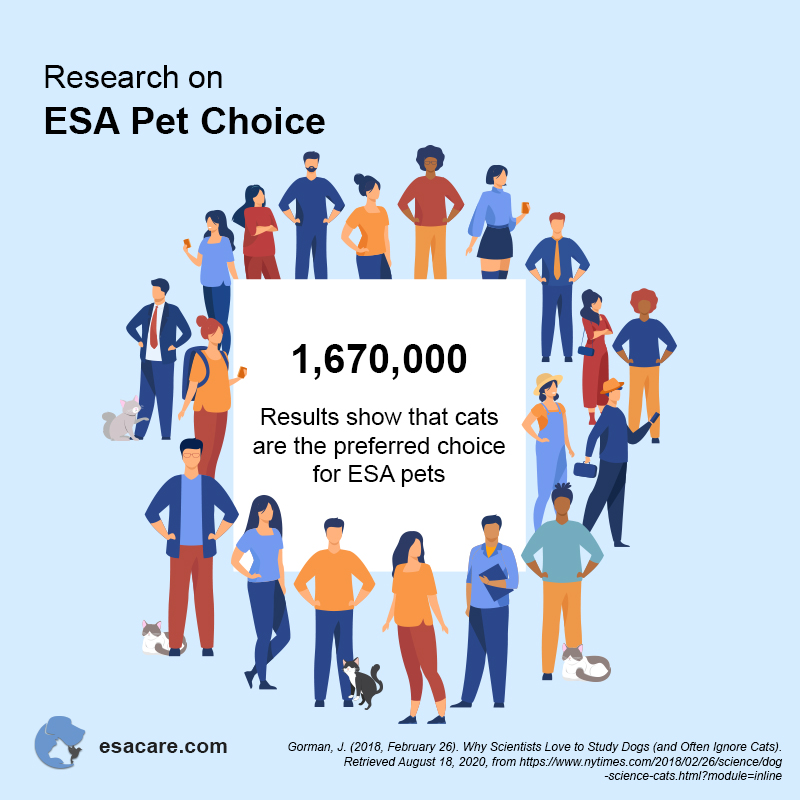These 7 Cat Breeds Make The Best Emotional Support Animals
Over the recent past, Emotional Support Animals have become common. Today, you’ll come across different people with Emotional Support Animals, even in public places. For instance, in most public means of transport, you’ll find countless passengers traveling with their Emotional Support Animals.
Emotional Support Animals are often confused with service animals, but the two play quite different roles.
An Emotional Support Animal is more than a pet – Click the button below.
Table of Contents
What are the benefits of Emotional Support Animals?
Emotional Support Animals are increasingly being advocated for by healthcare professionals. Some of the conditions where ESAs are recommended include;
- PTSD
- Depression
- General anxiety disorder
- Social disorder
- Aerophobia
- Agoraphobia
The benefits of using emotional support animals are clearly evident with their continued growth. These benefits include;
- They act as a motivating factor.
- They help patients feel comfortable and safe.
- They help their owners become more sociable.
- They have been known to diagnose illnesses early.
- They help boost the owner’s esteem and confidence.
- They offer a sense of purpose and responsibility to the owner.
There have been numerous studies investigating the benefits of these Emotional Support Animals. And while more studies are still underway, the advantages of having an ESA are apparent.

Best Cat Breeds
What is the best emotional support animal?
The question then turns to, what is the best support animal for you? Ultimately, this question will be influenced by several factors. These include where you live, ESA guidelines and policies in your region, and your general preferences.
Cats, as it turns out, are one of the most popular Emotional Support Animals. However, not every cat is a personal support cat. There are numerous breeds of cats, and unfortunately, not all of them make the best Emotional Support Animals.
For a cat to qualify to be an ESA, it needs to have most or all of these qualities;
- The cat should be sociable and enjoy the company of humans.
- They should be calm and not startled easily.
- The cat shouldn’t be bothered by loud noises, dogs barking, yelling, and noise from machines and other equipment.
- They should also quickly adapt to new environments.
What cat breeds make the best Emotional Support Animals?
While almost all cats make great pets, not all cats can act as your Emotional Support Animals, according to the criteria list above. If you are looking for the best breeds, here’s all the information you need to find the right emotional support cat.
An ESA pet can improve your lifestyle – Click the button below.
Number One: The Ragdoll Cat
The Ragdoll cat is an excellent choice for the emotional support cat list. For starters, the relatively long lifespan of 15 years makes them a companion that lasts. The average Ragdoll cat measures about 25 inches and weighs from 6 to 20 pounds.
Ragdoll cats have their roots deeply seeded in the United States. They are usually easy to identify from their colorful fur across their body. Some of the common Ragdoll fur colors include lilac, chocolate, seal, and blue.
Personality
Ragdolls are among the favorite emotional support cats as they meet the above-mentioned qualification criteria. Ragdoll cats are usually calm, gentle, and socialize well, even with kids. These qualities make Ragdoll cats an integral companion when you’re going through tough times.
One little known fact about Ragdoll cats is they are also called the puppy-dog cat. This is because of their playful nature, a unique and advantageous quality against other cats.
Habits
Ragdolls can adapt to new environments rather quickly. They are also easy to train using the litter bin.
These cats are famous for creating a strong bond with the owner. Whenever they’re around you, they’ll always want to be near you. Since they are a calm breed, you don’t have to worry about ragdolls disturbing your peace.
Not many people know where these adorable cats get their names. If you’re in these categories, you’ll be lucky to learn the name from one of their popular habits. Ragdoll cats tend to relax or go limp whenever someone picks them up, just like a ragdoll.

Ragdoll Characteristics
Health
As you consider getting an emotional support cat, you should realize that cats, too, get sick just like you. Before selecting the best cat breed to be your emotional support animal, you should first analyze the breed’s health issues.
Ragdolls, for instance, are prone to different conditions and health issues when not properly taken care of. Remember, getting an emotional support cat is committing to a symbiotic relationship.
Just like the cat will help you heal and take care of you, they also need to be taken care of. Ideally, you should take your Ragdoll to the vet to be screened for different diseases and medical conditions. These include;
- Heart complications
- Kidney problems
- Gastrointestinal tract infections
- Oral cavity contagions
Diet
Ragdolls are known to be inherently predisposed to dietary problems such as overfeeding. From their playful nature, Ragdoll cats are always hungry, and they love to eat. This may lead to some added weight, which is usually hard to notice in the initial stages. When you finally notice it, it becomes expensive to regulate.
To keep your emotional support Ragdoll from adding weight, monitor what they consume and the irregularity. Additionally, you can get the right dietary guidelines when adopting them, or even from your local veterinarian.
Book an Appointment by clicking the banner below.
Number Two: The Maine Coon Cat
Getting their name from their State of origin, the Maine Coon is another excellent candidate for the emotional support cat list. They usually live for between 9 to 13 years and, depending on the gender, measure about 8 to 16 inches.
The American bred cat has numerous colors that usually combine and create beautiful patterns on the fur. The most common color combos include black, cream, white, brown, and gold.
Personality
Maine Coons are known for their sweet temperament. They are usually very cool, gentle, and friendly. And while they do like getting attention, Maine Coons are rarely clingy. That means they’ll stay around you with minimum distractions or call for attention. These qualities make the Maine Coon an excellent candidate for an emotional support animal.
Maine Coons are also playful and often enjoy playing with soft toys, small balls, and general games. If you don’t get your Maine Coons these toys or engage them in these simple animal games, the cats will start playing with pretty much everything.
If you are looking for a playful Maine Coon, you should get a male as they are spirited and lively. Female Maine Coons, on the other hand, are considered refined and classy.
Habits
If you ask a random person what they know about cats, among the answers you’ll get is their distaste for water. Cats notoriously hate getting into the water and sometimes go to great lengths to avoid water contact.
The Maine Coon, however, is a water enthusiast. Unlike other cats, Maine Coons love to be in the water and even jump into water paddles and bodies like bathtubs. If you get a Maine Coon as your emotional animal support, play with it around water now and then. For example, you can set up a pool in your yard on a sunny day and let the cat play around with the water.
Another well-known practice common in Mane Coons is their love of sleep. On a typical day, a Maine Coon will take a nap at least twice.
Since they are a very playful breed, Maine Coons don’t like being alone. Just like dogs, Maine Coons love to be around your company and will tend to hang around when you have visitors and family over.

Maine Coon’s Characteristics
Health
Maine Coons are a strong and resilient brand of cats. However, they have a relatively high chance of contracting diseases and health conditions in the following organs;
- Heart
- Kidney
- Muscles
- Bones
To monitor your Maine coon’s health status, keep an eye out for lazy behavior and skipping meals. When your cat starts displaying such signs, rush them to the vet as it could be a budding infection.
Diet
Since these cats are playful and very active, they always have an appetite. However, you need to watch what they feed as it could easily lead to obesity. Another reason to be careful with your cat’s diet is that Maine Coons are susceptible to toxicity and dietary problems from various foods. These include;
- Chocolate
- Garlic
- Onion
- Dog food
- Dough with yeast
It is easy to get your hands on an ESA letter. Get yours now by clicking the button below.
Number Three: The American Bobtail Cat
As the name suggests, the American Bobtail is another native cat with its roots right in America. American Bobtail cats are medium in size, and they have an iconic short tail. This characteristic is the source of their name.
American Bobtails measure from 1 to 4 inches and they can averagely live from 11 to 15 years. These cats can naturally have a wide array of colors and patterns. The common ones are black and white cat breeds, brown, cinnamon, and chocolate.
Personality
When you think about it, cats and dogs are very different in nature. Most people identify either as dog lovers or cat lovers.
But what if there’s a way to be both a cat person and a dog person? While this is not uncommon, in this case, it is the American Bobtail cat that has a personality between that of a dog and a cat. These cats are intelligent and love to play with toys, humans, puzzles, and learn new tricks.
American bobtails are known for their adaptability, a suitable character for different kinds of owners and families. If you’re a calm person, the cat will adapt to this and develop a calm and collected demeanor. If you’re playful, on the other hand, the cat develops a jovial, playful persona.
This adaptableness feature in American Bobtail cats is seen as a superpower by some people. That’s because the cat is an ideal choice for people suffering from different illnesses and conditions. This is why American bobtail cats are some of the most common Emotional Support Animals.
Additionally, these cats don’t show any aggression, making them an ideal choice, even for kids.
Habits
American Bobtails are playful and like to be kept busy for long durations. They are also an obedient breed and listen to any instructions. They’ll even fetch toys you throw, just like dogs.
They love hiding and escaping, and they are excellent at it. So, you’ll have to keep your eyes on most of the time. Additionally, you’ll have to occasionally trim their nails as they love scratching furniture and curtains when they get bored.

American Bobtail Personality
Health
Another reason why American Bobtails are so popular is because of their stellar health condition. American Bobtails don’t have any historical genetic disorders.
However, from their short tails and spine, they can sometimes develop spine issues. Mostly, these issues are from the pressure that builds up at the spine and needs professional intervention.
Some American Bobtails have been diagnosed with issues relating to the heart and kidneys in a few cases. So, it’s important to have a vet check your American Bobtail emotional support cat every so often. If there are no outstanding issues, the vet will guide you on how often you should schedule the next checkup assessment.
Diet
American Bobtails once again display how they are like both cats and dogs. Like other cats, they love eating meat. Like their canine counterparts, American Bobcats also love eating all sorts of food, from cookies to apples.
However, when you have an American Bobtail cat, you should keep it on a strict diet of fat and meat. This, too, must be monitored to ensure the cat doesn’t become obese.
Cats can be a great support system in times of need – Click the button below.
Number Four: The Siamese Cat
The Siamese cat is a small-sized breed that grows up to a length of 20 inches. Siamese cats originated from Thailand, but today, they can be found all over the world.
These cats can live from 8 to 15 years and are identifiable by the pale body and colored patterns on their tails, faces, and limbs. These patterns are mostly cream, cinnamon, fawn, or chocolate in color. Selective cross-breeding is the root of these specific colors and patterns.
Personality
Siamese cats are known for the colorful patterns and colors in their fur. However, beyond the striking beauty, Siamese cats are also brilliant. They love learning new tricks and playing with toys and simple objects. They are also social cats and love expressing themselves.
Additionally, an easily noticeable characteristic is how protective these cats are. Whenever they feel like the owner is in danger, they will not hesitate to protect them.
They are also an affectionate breed and love being by the owner’s side at all times. In most cases, Siamese cats like sleeping with you in bed or lying on your lap during the day.
Habits
One of the key characteristics found in humans is the ability to have totally different personalities and habits. Siamese cats borrow this characteristic as they can be unique and different. They do, however, exhibit a few traits that are common across the breed.
These include their love for heights. Siamese cats like to stay in high places such as tables and bookshelves. Occasionally, you’ll see them jumping through these high objects as they move around the house.
They also love playing games and will spend most of their time playing with softballs, shoestrings, and squeaking toys. Siamese cats love your attention as they play.

Siamese Cat as Emotional Support Cat
Health
Siamese cats are very affectionate and make excellent Emotional Support Animals. However, they also need your attention and care. Some of the conditions to look out for when you have a Siamese cat are;
- Skin disorders
- Hepatic disorder
- Renal disorder
- Hearing conditions
- Respiratory illnesses
Diet
From the measurements mentioned above, you can deduct that Siamese cats are relatively small. Because of this, you must watch what they eat, as the wrong diet could lead them to add weight. Since the cat is a tiny breed, the small legs cannot support an obese body.
Additionally, Siamese cats need to be kept on a closely monitored diet of wet and dry foods. Most Siamese cat owners end up feeding the cat dry foods, which have low nutritional value and can lead to obesity. Oh, fun fact, Siamese cats are also called Meezers.
Book an Appointment by clicking the banner below.
Number Five: The Russian Blue Cat
With its origin from Russia, the Russian Blue cat is a great companion for anyone seeking an emotional support cat. This, one of the small cat breeds, grows to about 18 inches in length. It can also live up to 15 years, depending on their health status.
Russian Blue cats are grey in color with hints of silver stripes. The stripes are more prominent in kittens but fade away as the cat approaches adulthood.
Personality
Russian Blues are gentle, quiet, and shy cats. However, this does not get in the way of expressing their fun side as they love playing around, jumping, and mounting high objects.
These cats are also super intelligent and often observe people and activities before choosing whether to engage or not. The Russian cats are also a kind breed and care for their owner.
Russian Blues get attached to the owners, and if you deny them the attention they crave so much, they often feel hurt.
One strange characteristic unique to the Russian Blue is their ability to possess self-worth. That’s right, absurd as it may sound, these cats have a human-like like, making them an ideal candidate for those people who consider themselves as serious.
Habits
As seen above, the Russian Blue is one of the unique cat breeds that share characteristics close to humans. Another characteristic is these cats love to stay clean. When they’re doing nothing, you’ll often see them start to clean themselves.
They are also well mannered and don’t show aggression towards humans. They scare easily, and surprises make them anxious. They don’t communicate audibly too much as they are a shy breed. They do, however, respond whenever you try interacting with them.

A Cat can do Wonders for your Mental Health
Health
The Russian Blue is another healthy breed that doesn’t have a history of genetic disorders. However, you still need to keep an eye on their health to ensure they don’t suffer from health conditions in common areas such as the eyes and the urinary tract.
Overall, with general care, your Russian Blue cat will live a long and healthy life.
Diet
Like many other cat breeds, the Russian Blue is very playful. As a result, it builds up quite an appetite, and its diet consists mainly of high-protein foods. However, you should regulate what the cat gets to eat and add undesirable weight.
While they may sound like they’re always asking for food, you should be strict when dividing the portions it can have during the day. This will help you reduce the chance of your cat getting these diseases.
Stay mentally fit with your ESA pet! – Click the button below.
Number Six: The American Shorthair Cat
The American Shorthair hails from the United States and has one of the longest lifespans in all emotional support cats. These cats can live to be 15 years old, with some extending to 20 years.
The American Shorthair measures about 15 inches in length but can sometimes grow longer, especially for males. These cats have a variety of colors and patterns all over their fur. Some of the common colors include gold, brown, tortoiseshell, white and black.
Personality
American Shorthair cats are friendly in nature and pleasant to be around. This quality also makes them a friendly option, even for kids.
Additionally, American Shorthair cats are not clingy and will never crave your attention. Whenever they are in a jovial mood or want to play, they will bring their favorite toy to you.
Since they are also adaptable to many environments, you can have them in most regions. And when you’re traveling with them, you don’t have to worry about their adaptableness.
American Shorthair cats are also known for their increased intelligence. They love to play with puzzles, toys, and games that require some level of brainpower use. These qualities make the American Shorthair cat one of the best Emotional Support Animals around today.
Habits
The American Shorthair cat does not have a history of genetic illnesses. However, they are susceptible to some conditions, which is why you should have regular vet checkups. Some of these conditions include;
- Joint issues
- Renal conditions
- Cardiovascular illnesses

Register an Emotional Support Cat
Diet
Just like a majority of other emotional support cats, you need to watch what your cat consumes. You can determine this with the help of a vet who’ll give you food portions depending on your cat’s weight, age, and activity level.
If left to their own way, American shorthair cats would eat until they are obese.
Number Seven: The Persian Cat
The Persian Cat has its origins from Persia or modern-day Iran. The cat can live up to 15 years and measures around 18 inches long once mature. However, some males can grow longer.
While Persian cats are medium in size, they have a heavy fur coat and heavy bones. These features make them appear one of the big cat breeds than they really are.
Persian cats don’t have any distinguishing colors or patterns. Nonetheless, some of the dominant colors in this breed are black cat breeds, white, chocolate, gold, brown, and silver.
Personality
The Persian cat is the most popular breed in the world and needs little introduction. Chances are, you’ve come quite across several Persian cats as they are found everywhere. Their beauty is one of the reasons these cats have always been popular.
Persian cats don’t lose their playful kitten-like behavior even when they grow up. They sometimes show favoritism and discrimination by refusing to show any affection to outsiders and strangers. In some cases, they may even hide when you have visitors over.
As mentioned, these cats are playful in nature and love playing chasing games such as following a laser dot or fetching a yarn ball. They can, however, get picky about when they want to play and their game of choice.

ESA Pet Choice
Habits
While they may be found in most parts of the world, Persian cats are slow to adapt to new environments. That makes them an ideal choice if you don’t like moving around frequently. If their environment is constantly altered, these cats can end up suffering from anxiety.
Moreover, these cats love sleeping and will spend most of their time in bed. They only get out of their sleeping area when they need to eat, play, or use the litter box. While they love their privacy, Persian cats don’t like being left on their own for a long time.
Persian cats are very particular about how clean their litter box should be. In some cases, if you fail to clean the litter bin, they will find a new clean place to relieve themselves.
Health
Adorable as this cat may be, they are predisposed to several genetic and non-genetic conditions. Due to their light fur, Persian cats shed a lot and maybe susceptible to skin infections. Some of the conditions to watch out for when you have an emotional support animal include;
- Skin issues
- Eyesight problems
- Cardio issues
- Respiratory issues
Diet
The Persian cat borrows some of its dietary characteristics from Siamese cats. They, too, must be fed wet food in the right portions.
Are you feeling emotionally unstable? Keep your ESA pet close – Click the button below.
Conclusion
Finally, having a cat as an emotional support animal is a great idea as you’ll benefit in myriad ways. At the same time, these cats will also get new homes, food, and the affection they need to grow and thrive.
For your emotional support cat to be recognized by various legal and public entities, you’ll need to get an Emotional Support Animal Letter. Once through the process, you’ll go ahead and get one of these 7 felines as your emotional support cat.
Contact us or Book an Appointment by clicking the banner below.










 347 5th Ave Suite 1402-112,
347 5th Ave Suite 1402-112,

Leave a Reply
Want to join the discussion?Feel free to contribute!